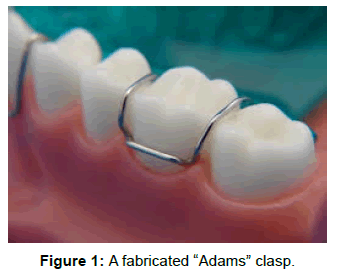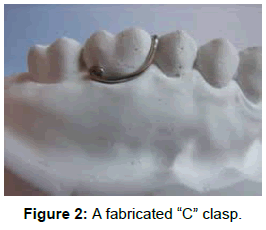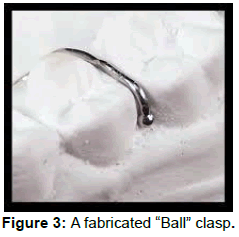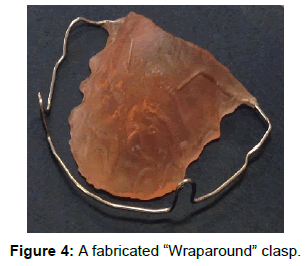Perspective Article Open Access
Removable Orthodontic Appliances: The Mechanical Efficiency
Zafarmand and A Hamid*Department of Orthodontics, Shahid Beheshti University of Medical Sciences, School of Dentistry, Evin, Tehran, IR Iran
- *Corresponding Author:
- Zafarmand AH
Associate Professor
Department of Orthodontics
Shahid Beheshti University of Medical Sciences
School of Dentistry, Evin, Tehran IR, Iran
Tel: +98 (21) 22 4218 13
E-mail: zafarmand@alum.bu.edu
Received Date: November 08, 2016; Accepted Date: December 10, 2016; Published Date: December 18, 2016
Citation: Zafarmand AH (2016) Removable Orthodontic Appliances: The Mechanical Efficiency. Pediatr Dent Care 1:124.
Copyright: © 2016 Zafarmand AH. This is an open-access article distributed under the terms of the Creative Commons Attribution License, which permits unrestricted use, distribution, and reproduction in any medium, provided the original author and source are credited.
Visit for more related articles at Neonatal and Pediatric Medicine
Abstract
Removable appliance should be considered as a method of interceptive orthodontic treatment and is mostly used in the mix dentition period. It basically either resolves the imminent dental problem or diminishes its severity. This is undoubtedly beneficial to the patient, in either way. However, since it is a patient-dependent, stability of the appliance in the place is very imperative. The stability is fulfilled by retentive clasps located on the appliance. This fulfillment has a substantial mechanical concept for designing. This article is a scrutiny on the retentive perspective of the appliance based upon principles of mechanics.
Keywords
Orthodontic removable appliance; Appliance clasp; Mechanics
Introduction
Removable appliances take a considerable share in contemporary orthodontic treatments. The appliance was the innovation of George Crozat, in the early 1900s. It was later more developed in European countries, but had fewer roles in the mainstream of the United States orthodontics. Instead, American orthodontists tended to use almost exclusively fix appliances. In fact, Europeans pioneered the “functional” application of removable appliances for growth modification, at large [1]. These appliances would resolve minor to mild dental problems or can reduce the length of fix treatment, at least. However, the key success of treatment is the patient compliance with the appliance [2]. The looseness and soft tissue irritation of the gadget would definitely reduce the success rate of treatment.
One the most important factor for wearing an appliance is its retention. This is fulfilled with the parts so called Clasps. Clasps and springs should be designed in a way that functions properly and efficiently. Bulky clasps can diminish the desire of wearing the gadget by youngsters, resulting in frustration of patient and disruption of the process of treatment, as well.
A number of clasps are recommended for retention in removable appliances. Among all, “Adams Clasp” (Figure 1) is the one that is used frequently. The other choices to be considered are “C” (Figure 2), “Ball” (Figure 3), and “Wraparound” (Figure 4) clasps. Each of these clasps can provide different levels of mechanical retention for appliance in the mouth. Obviously, the best one is the one that work the most efficient [3]. However, there are benefits yet some defined indications with application of “Ball” and “Wraparound” clasps. There should be two in-contact teeth for application of “Ball”; and the design of “Wraparound” would be suitable mostly for retainer appliance. Finally, this article intends to discuss the priority of “C” clasp over “Adams”, from mechanical perspective.
Discussion
Quite frankly, there are 8 reasons that prove this superiority, although “C” is used much less and neglected in current orthodontic practice and literature. These are the followings:
Extensive tooth contact
While Adams has a two-point contact, “C” clasp establishes a linecontact with the tooth.
Better undercut rest
“C” clasp lies completely down under height of contour of the tooth but Adams does not. In fact, lab technicians must take off a part of plaster when fabricating Adams for better fitness. This becomes more critical when applying on primary tooth. This is due to the fact that the height of contour of permanent tooth is on the middle third, but it is on the gingival third for the primary tooth.
No gingival impingement
The “C” clasp is very gentle to the anchor tooth. Once again, trimming the plaster for placement of Adams clasp means the absolute pressure on the gingival papilla and inconvenience for patient.
Easier fabrication
The simplicity of the “C” clasp makes its fabrication much easier than of Adams clasp. Thus, it requires much less time for preparation.
Easier adjustment
Even a not fully formed “C” clasp can be adjusted chair side at the appliance delivery appointment. The clasps of removable appliances will usually need readjustments in recall visits, for various reasons. For example, even proper wearing and taking off the appliance may weaken the fitness of appliance. Some kids may abuse the appliance when wearing. Unfortunately, there are children that may over activate the active auxiliaries for expediting the tooth movement. Finally, in a compliant patient, springs need readjustment in each recall visit.
As is shown in Figures 1 and 2, it is remarkable that only one end of a “C” clasp is restricted in acryl, while Adams has both ends embedded in acryl. Obviously, adjustment of one free-end clasp is much easier than a both-end restricted clasp.
Less occlusal interference
The Adams occupies over two interdental contacts, while “C” only passes over only one contact. Mostly, the occlusal extension of the Adams causes a bother for patient when closing jaws, even with a wellfabricated one.
More clasps
A clasp that occupies only one contact (C) permits placement of more clasps on other present teeth. Moreover, in mixed dentition cases where some primary teeth are already exfoliated or ready to exfoliate, it makes some restrictions for technician and clinician for prescribing a clasp, due to limited number of anchor teeth.
Less cost
The wire length used for a “C” is at least one half of the length of wire used for an Adams clasp. After all, this is a saving for frequent removable appliance fabricators.
Conclusion
Retention of a removable appliance is the least expectation for persuading the patient to wearing. According to the above reasons the “C” clasp is much recommendable for better retention of the removable appliances.
References
- Proffit WJ, Fields HW, Sarver DM (2013) Contemporary Orthodontic Appliances - Chapter 10, in: Contemporary Orthodontics. Elsevier 5: 347-395.
- Schott TC, Meyer-Gutknecht H, Mayer N, Weber J, Weimer K (2016) A comparison between indirect and objective wear-time assessment of removable orthodontic appliances. Eur J Orthod 1: 2-6.
- Zafarmand AH, Zafarmand MM (2013) Removable orthodontic appliances: New perspectives on capabilities and efficiency. Europ J of Paediat Dent 14: 160-165.
Relevant Topics
- About the Journal
- Birth Complications
- Breastfeeding
- Bronchopulmonary Dysplasia
- Feeding Disorders
- Gestational diabetes
- Neonatal Anemia
- Neonatal Breastfeeding
- Neonatal Care
- Neonatal Disease
- Neonatal Drugs
- Neonatal Health
- Neonatal Infections
- Neonatal Intensive Care
- Neonatal Seizure
- Neonatal Sepsis
- Neonatal Stroke
- Newborn Jaundice
- Newborns Screening
- Premature Infants
- Sepsis in Neonatal
- Vaccines and Immunity for Newborns
Recommended Journals
Article Tools
Article Usage
- Total views: 10723
- [From(publication date):
specialissue-2016 - Apr 01, 2025] - Breakdown by view type
- HTML page views : 9563
- PDF downloads : 1160




